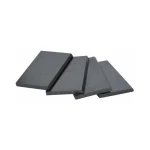Description
Graphite & Fiber Vanes for vacuum pump rotors
An Essential Part of Vacuum Pumps. The working principle of vacuum pump is to compress gas and discharge it by rotating rotors and vanes. Specifically, as the graphite rotor rotates, the space between the vacuum pump graphite vanes and the pump body continuously changes, thus sucking, compressing, and discharging gas. The main function of the graphite blades is to capture the gas and move it from the low pressure area to the high pressure area when they rotate inside the vacuum pump. The quantity, shape, and material of the graphite vanes have an influence on the performance and service life of the vacuum pump.
Vacuum pump graphite rotors and vanes have good self-lubrication and wear resistance and can work normally in dry-running state without additional lubricating oil or grease. Therefore, they can effectively avoid the contamination and damage to the vacuum pump caused by lubricating oil or grease. Meanwhile, they have good corrosion resistance and high temperature resistance, and can adapt to harsh working environments, so they are widely used in dry vacuum pumps.
Replacement of vanes servicing
Features of vanes
- Low coefficient of thermal expansion, low friction coefficient
- Excellent self-lubrication.
- High thermal conductivity and thermal stability.
- Good chemical stability & corrosion resistance.
- Wear resistance and high mechanical strength.
Resin Impregnation Vanes specs
| Density (g/cc) | Porosity | Shore Hardness | Compressive Strength (Mpa) | Flexural Strength (Mpa) | CTE (×10-6°C-1) | Max Working Temperature |
|---|
| 1.8 | 2% | 60 | 110 | 65 | – | 200 °C |
Notes:
- 1 MPa = 10.2 kgf/cm2; 1 W/m.k = 0.86 kcal/cm.h.°C
- These properties are typical values and not guaranteed.
Size of VANES in millimeters
















































Reviews
There are no reviews yet.